Last Saturday we woke up way-too-early for a way-too-cold-for-July morning adventure. Yet, in spite of our groggy protestations, we knew we'd made a good decision as soon as we arrived at Sherwood Orchards. We discovered the farm in mid-October of last year when I got an itch to make quince paste, but refused to pay the premium at the markets in-town. After a little research, we found this farm just down highway 99 that had a few rows of quince trees, along with dozens of varieties of heirloom apples. We picked boxes worth of fruit and went home happy, redolent of quince's potent and flowery aroma.
Following a few months off, Sherwood Orchards opened for this year's season at the beginning of July. And with that announcement, we returned in search of another hard-to-find fruit: pie cherries. Luckily, the fiery older couple that runs the farm have sour montmorency cherries in spades. Pie cherries are almost comically perfect in their appearance, resembling a child's drawing of a cherry: plump, glossy red, and paired off on dangling stems. They also happen to be bracingly tart, which makes them perfect for sour jams and well-balanced pies. We picked 9 pounds for canning and freezing.
But we didn't leave before gathering 11 more pounds of Sherwood's sweet varieties. While the richly-colored, inky Vans were few-and-far between, we managed to find a few dozen of the grape-flavored fruits. We had much better luck with the Royal Annes, which also happen to be one of my favorite varieties. They usually have a blushing hue and marvelous sweetness, but these particular Royal Annes also gave off the strongest almond scent I've ever smelled in a cherry. I finally understood the French tradition of including stone fruit pits in desserts for their almond-like flavor. A and I were so taken by the heady perfume of the cherries that we had to stop ourselves from eating more fruits than we put in our buckets.
Last year, we ended up making far too many jars of each jam that we tried, which meant we didn't try as many varieties as we would have liked. To spread out the enjoyment and expand our options, we're trying to make smaller batches this year and try new recipes like fig preserves or plum jam. We're already planning on returning to Sherwood Orchards for some August peaches.
You can view more of our photos from last fall's visit to Sherwood Orchards here.
Thursday, July 16, 2009
cherry-pickin'
Posted by
p
at
9:31 PM
0
comments
![]()
Monday, July 13, 2009
city-slicker campfire gourmet
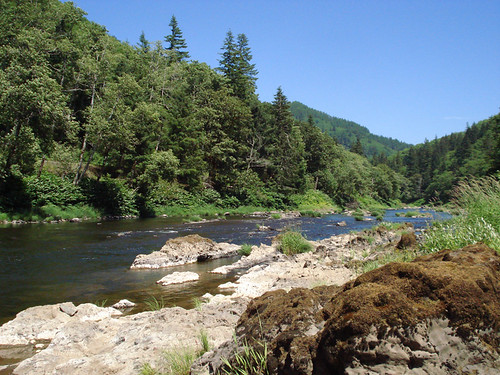
Temperatures were pushing the mid-nineties and A and I were tiring of the nightly, clockwork, 10pm report of our neighbor's pre-4th fireworks. When our friends Kate and Kalin invited us along for a last minute holiday weekend camp-out, we jumped at the chance to skip town. It sounded like fun, until we dug out our tent and camp stove from the crawlspace to find a heavy layer of dust. I guess it's been a while since we've been camping.
In reality, we had little to worry about, since Kalin served as the quartermaster for our college's Semester in the West program. If he could handle two dozen co-eds for 4 months in the rural West, he could probably keep A and I out of trouble for one night in the woods. That is, if we were even able to find a spot to sleep. Most seasoned campers would probably scoff at the 4th of July weekend as a foolhardy time to go camping, but with Kalin's re-assurance, we let go of our anxieties and trusted that if worse came to worse, he would hack through the underbrush to clear us a site.
We drove toward the coast to stop at Nehalem Falls, where we completely lucked out by finding what well may have been the last remaining camp site in all of Oregon. It was small, but totally serviceable, and within earshot and a short walk of the nearby water. We spent a lazy afternoon along the river, counting salamanders, drinking beers, and by turns paddling against and floating with the current. But eventually, we had to eat.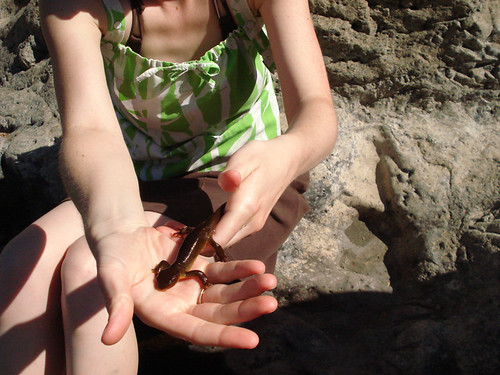
Our friends, wisely assessing the range of our outdoor survival skills, put us in charge of dinner. To prepare, A and I spent a few nights weighing out the merits and challenges of an ongoing list of "simple" foods. Unfortunately, we quickly realized that "home" simple is different that "woods" simple. In fact, a lot of our quick knock-out meals use a lengthy list of pantry and fridge staples, not to mention a bewildering array of pots and pans. If we'd wanted simple, we should have gone with hot dogs. In any event, we had a culinary reputation to maintain, so we settled on a few dishes that we could make with a limited range of camping cookware.
The menu? Penne puttanesca, kale and cherry salad, boozy campfire cheese and, of course, smores. We figured that by mainly using tinned or preserved ingredients (kalamata olives, tuna, anchovies), puttanesca would be easy to transport. To make matters simpler, we pre-cooked all of the noodles so that boiling water wouldn't be a strain on our water supply. The pasta was a good choice, since it tasted just as good once it cools off, which seems to happen quite rapidly when camping. The only hitch we hadn't anticipated was chopping herbs and garlic, but the back of a Rubbermaid tub lid made for a serviceable cutting board.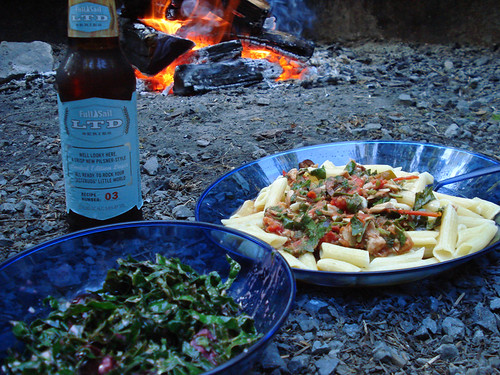
As for the salad, it was our spin on a favorite dish from Dove Vivi. There, they finely shred lacinato kale leaves and toss them with a lemon-and-garlic heavy dressing and shards of ricotta salata. For our purposes, we made a creamy lemon-chevre dressing and threw in a handful of pitted and smashed cherries for a sweet counterpoint. It greatly helped to lightly sauté the kale to take just a bit of the bite off of it (though a longer bath in the dressing would likely accomplish the same thing). I think the salad was so good that we'll probably re-visit it at home; hopefully the taste compares even without the wood smoke.
We were eating well, but we certainly weren't stuffed yet. To fill that what-do-we-eat-now period between dinner and dessert, we took a cue from Chow.com's camp-food article and tried out their campfire cheese. Simply put, douse a wheel of soft-ripened, bloomy-rind cheese with liquor, wrap it in foil, and bury it in the coals. In place of the recommended brandy, we used the bottle of bourbon we had on it. American-made booze for an American holiday. It came out beautifully.
For dessert, smores were an easy choice. What wasn't so easy was talking A out of trying to make her own marshmallows to bring along with artisan chocolate and fresh-baked graham crackers. As much as we care about ingredient provenance, there are some things that just aren't worth messing with. Our only innovation came thanks to Kate and Kalin's telescoping, rotisserie marshmallow skewers. Well-fed, it seems that life in the great outdoors ain't so bad. We hope we earned ourselves a repeat invitation.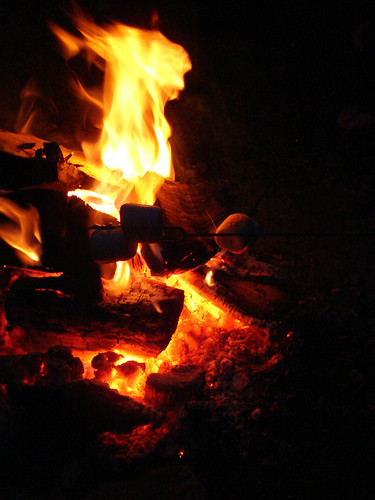
Posted by
p
at
9:24 PM
1 comments
![]()
Thursday, July 9, 2009
new york glimpses: farm-fresh
If you were worried that our week in New York left us starved for the bountiful Portland markets, you can rest safely assured that we did manage to find some good farm-to-table meals. While it might be hard to imagine that such a bustling metropolis leaves much room for agriculture, New York has a surprisingly vibrant farm-fresh community. Let's not forget that NYC does play home to urban CSAs, a thriving Greenmarket network, two Edible publications, and Slow Food USA's national office. We made an effort to see it all.
A lot of the sustainable food efforts begin in Brooklyn (space is, afterall, a bit more available than in Manhattan). Just a week before we arrived, the first-ever Brooklyn Food Conference drew food movement heavyweights to discuss social equity and local food access. And a week after our return, I read about a rooftop farm in industrial Greenpoint that's beginning to supply local cafes. Good things are growing.
Off a side street in Williamsburg, egg is dishing up simple, farm-fresh meals in a bright and spare space that belies its hearty Southern appetite. With crayons on the tables and groggy, bleary-eyed hipsters waiting on the sidewalk, we should have known to expect some serious hangover-busting vittles. To share, we ordered a serving of the house-made sorghum granola (a breakfast appetizer?), while A chose the biscuit sandwich and I went for the "Eggs Rothko." What a glorious mistake. Of course it was too much food, but at least it was too much delicious food. A's sandwich split a crisp, craggy biscuit to contain a mound of fried country ham, fig jam and farmhouse cheddar. My Eggs Rothko took a spin on a classic egg-in-a-basket by cooking an egg inside a thick slab of brioche, then broiling it all beneath a generous heaping of grated cheese. Taken with a forkful of country ham shavings and broiled tomatoes, every bite was a toothsome wonder.
We enjoyed our meal in the scant shelter of a small front patio, bordered by a miniature vegetable garden. To supplement their adorable street-side tomato planter, the chefs of egg have started a farm in the Catskills, which they document on their simple and engaging blog. Any size garden is an exercise in humility, but for a restaurant, it also offers a hearty dose of empathy with your suppliers.
That same in-house commitment to ingredients and artisan labor informs the staff at Diner, along with their sister restaurants Marlow & Sons and Bonita. We've written before about the Diner family of restaurants and our huge crush on their work, which ranges from in-house butchering to an awesome food journal. Well, after a long time of ogling from afar, we finally had a chance to taste their cooking. Now A and I don't cook meat all too often (even though we still have two hens and 20 lbs of pork in our freezer), but we do like to sometimes order it out if we trust the source. Given the fact that Diner buys whole-animals from local farmers and breaks them down to their chef's specifications, there was no way we were going to miss the meat when we stopped by Bonita early in the week. I had a trio of killer steak tacos, while A went for a deliciously juicy pork burrito. It was worth the wait.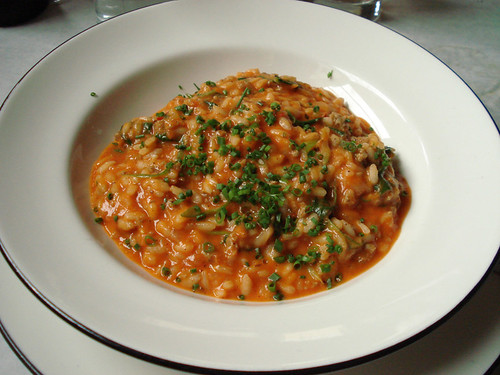
A few days later, after a morning of sustainable food gab with the gracious staff at Slow Food USA, we made our way over to the train-car diner named Diner for an early lunch. The interior was bright and quiet on a weekday morning and charmingly worn-down, with old tile floors and wooden booths. A immediately zeroed in on a bowl of mussels swimming in a tomatillo and green onion broth (with a hearty helping of thick-cut fries, of course), while I ordered Diner's tomato-based risotto with housemade sausage. Both dishes were tangy and savory and completely comforting for a cool, overcast day.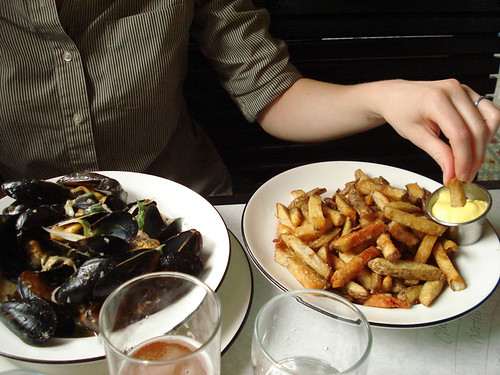
Just around the corner from Diner, Marlow & Sons vends local artisan products from a specialized grocery store/oyster bar. Had we not just eaten, we probably would have grabbed a stool for some local half-shells, but as it was, we contented ourselves by purchasing a food literary magazine and a collection of local chocolates.
We were bolstered to see (and sample) so many restaurants that were emphasizing local sourcing and old-school skills, yet one establishment puts them all to shame: Blue Hill. After last year's Slow Food Nation, A and I started nursing a longtime, big-time chef crush on Dan Barber. Apparently, we weren't alone. Just a few nights prior to our reservation, the Obamas chose it for their NYC date night, garnering some big points for supporting sustainable ag in the process. You see, Blue Hill isn't just any restaurant; it's not even just any restaurant with it's own farm. It is a restaurant with a fully-fledged agricultural education center. A few years after founding Blue Hill on a side street near NYU, Dan Barber connected with the Rockefeller family to open the Stone Barns Center for Food and Agriculture, just 30 miles up the Hudson River Valley. The center runs tours and classes about four-season agriculture and livestock husbandry, while also playing home to a very farm-focused, on-site restaurant.
As much as we wanted to visit the farm, we didn't exactly want to hitchhike out to Stone Barns, so we decided to stay in town and visit the Greenwich Village restaurant. We were seated on the back patio, which has the quiet feeling of an urban greenhouse. From the moment we sat down, we knew this meal would be unique. Before we'd even ordered, our server presented us with a row of diminutive, raw vegetables suspended on a small fence of skewers. This was immediately followed by homemade butter and lardo, paired with kale- and carrot-scented salts, and two adorable asparagus "burgers" on tiny brioche buns. Currently, a lot of chefs are getting awfully coy and playful with their amuses bouches, but something about Blue Hill's approach made it clear that these starters really were an introduction to the restaurant's farm-centric philosophy. They aren't just little foodie jokes, each bite is a primer for the simple, distinct flavors to follow.
I could truly write a lot about this meal, but I'll try to just outline what A and I shared. I ordered:
Spring vegetable salad with pistachio and homemade chevre
Cobia (a firm whitefish) with ramps and prosciutto-wrapped asparagus in a pistachio-caper sauce
A chose the "Farmer's Feast" tasting menu, which included:
Soft-shell crabs with rhubarb and spring lettuce salad
Poached egg in spring greens puree
Berkshire pig with burdock root and rhubarb
Chilled rhubarb soup with fromage blanc sorbet
Everything was phenomenally fresh and displayed a complete devotion to the essence of each vegetable. Every individual component of the composed salad we shared was prepared to best show-off its flavor; some were crisp and raw, others were lightly blanched, while still other ingredients were lightly marinated. I've never had a meal that tasted to simply, so clearly of the fresh produce it used. And I can think of no higher compliment for what Blue Hill is trying to do.



